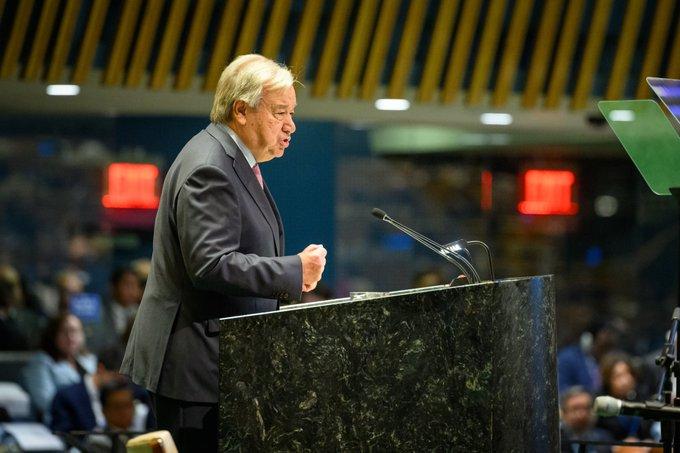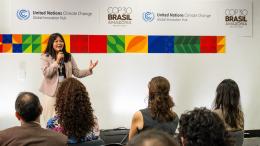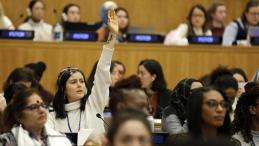Close watchers of the United Nations will note that the idea of an Envoy for Future Generations is not entirely new – the Secretary-General announced his intention to appoint the Envoy in his 2021 Our Common Agenda report (a similar idea was floated in the 2011 Earth Summit, and even in the 1987 Brundtland Commission report). However, after months of difficult negotiations in the lead-up to the Summit of the Future, many had assumed the issue had dropped off the table.
They (we) were wrong: the Secretary-General is going to deliver on this promise. And by all accounts quite soon.
The announcement for a UN Envoy for Future Generations, made at the Hamburg Sustainability Conference on 7 October, was one of the first actions taken by the Secretary-General following the recent Pact for the Future and Declaration on Future Generations.
Regardless of who is chosen for the role, there are at least three things the Envoy will need to focus on right away: representation, implementation and transformation.
Representation
By definition, a person from a future generation cannot participate in today’s decision-making. This means we can make decisions which have massive impacts on the wellbeing (or even existence) of future generations without facing any immediate repercussions. Just as previous envoys have helped to give voice to underrepresented groups (like youth), a core task of the Envoy for Future Generations will be representation of the needs and interests of people yet to be born.
This could be an extraordinarily heavy lift: think of all the forums where important global decisions are taking place (the Security Council, G7 summits, COP events, board meetings of major tech firms, etc.). How could a single envoy ensure that future generations are represented in each of these? The simple answer is they can’t. But they can push to accelerate a norm of representation across all our systems, reporting on progress, naming and shaming those who fail and offering advice on how to improve representation in all kinds of forums. And they can be a public voice that reminds all of us that our actions today have consequences for coming generations. Finland and Wales – both of which have created future generations roles in Government – show the enormous promise of representation.
Implementation
The Declaration on Future Generations contains many concrete actions for Member States and the United Nations system. A key role for the Envoy will be to support and catalyse implementation of these actions, and also connect and amplify ongoing initiatives around the world. For example, the Envoy might offer advice (and with funding, some capacity support) to Governments wishing to develop better foresight capacities, or stronger responses to large-scale risks or to understand how big demographic and/or environmental changes might affect them in the long term. And the Envoy can help countries learn from each other, drawing lessons from some of the innovative approaches already underway.
This could be measured: by the next Hamburg Sustainability Conference in June 2025, a certain number of Governments could develop foresight cells, or put in place measures to track the long-term impact of their investments. The United Nations system could equally report on how well future generations were represented in their decision-making bodies, or how they have put long-term visions into their work.
The corollary of implementation is accountability. The Envoy will almost certainly be asked to report on progress regarding the Declaration on Future Generations, so it will quickly become clear who is (and who is not) following through on their promises. In a non-binding process like the Pact for the Future, accountability is often one of the most important missing pieces.
Transformation
Seventy-five years ago, the Universal Declaration of Human Rights was adopted. It was a surprisingly short document (only 30 articles of one or two sentences each), but it created a long-term transformation around the world. Today, the Declaration has permeated every aspect of our lives: it has generated countless global initiatives around the right to education, health, asylum, religion, fair trial and fair work conditions; it has been adopted within the national legislation of most countries; and it is a constant reference point when we think of how to address new and emerging risks.
The role needs to embed long-term, multi-generational thinking into every aspect of our lives, our economies and our global governance systems.
Ultimately, an Envoy for Future Generations should have a similarly transformational task. The role needs to embed long-term, multi-generational thinking into every aspect of our lives, our economies and our global governance systems. Our measures of progress will need to evolve from economic development to a broader set of indicators that show we are thriving on a stable planet. This will require us to move beyond GDP, and to eventually put in place a circular economy that does not destroy the planet for generations to come. It will require us to respond to long-term risks like artificial intelligence, lethal autonomous weapons, synthetic biology, neurotechnology and geoengineering. In many respects, “future proofing” our systems will require us to “human proof” them, altering many of our most deeply-rooted tendencies to favour the present over the future.
An on-ramp to the future
If the three tasks of representation, implementation and transformation sound daunting, they should. It’s the kind of mission-impossible-mission that is typical of the United Nations system. But it is also one of the most important opportunities to generate real change emerging from the Summit of the Future.
To succeed, the incoming Envoy needs to be able to accelerate to maximum speed from the outset. This will require (1) a well-resourced team that can hit the ground running; (2) a group of Member States ready to push for implementation; and (3) a network of supportive organizations ready to amplify and expand the impact around the world.
Luckily, we have all three. Two years ago, the Secretary-General established the United Nations Futures Lab Network, which specializes in building up foresight capacities and long-term thinking within and beyond the United Nations. The Futures Lab would be a natural support structure for the Envoy and an important focal point within the United Nations system, though the Envoy would eventually need a broader set of capacities. Starting with an office is a huge advantage over other envoys who had to begin on their own.
It gets better: During the Summit of the Future, Jamaica and the Netherlands announced that they would form a Group of Friends of Future Generations, creating a Member State-led forum to push for implementation of the Declaration. This will be absolutely critical to the success of the Future Generations agenda and could become a real engine for those more transformational changes.
Last but not least, in 2023, an ImPact Coalition on Future Generations was created at a civil society summit in Nairobi. Comprised of hundreds of organizations and experts, this coalition is a ready-made force multiplier for the Envoy. It could act as an outer circle of support to the Envoy, helping to expand activities and connect with local initiatives around the world.
Foresight is a notoriously difficult exercise. Even the most sophisticated scenarios are mostly wrong, even about the near future. But one thing seems clear: the best chance for the incoming Envoy for Future Generations to succeed will be in harnessing these three capacities from day one.
Suggested citation: Day Adam., "Coming soon: a UN Envoy for Future Generations," UNU-CPR (blog), 2024-10-09, 2024, https://unu.edu/cpr/blog-post/coming-soon-un-envoy-future-generations.




